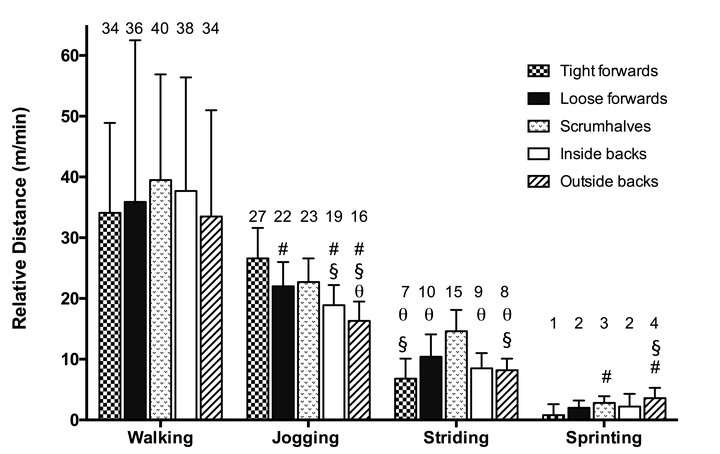Movement and impact characteristics of South African professional rugby union players

Abstract
Global positioning system (GPS) technology can provide accurate, non-invasive, real-time movement analysis of players participating in team sports. The application of this technology to rugby union will improve training practices by allowing improved understanding of movement characteristics and more individualised programmes. Nineteen professional rugby players were tracked using GPS systems during 24 matches during the 2013 rugby season. Players were grouped as (i) backs or forwards and (ii) tight forwards, loose forwards, scrumhalves, inside backs or outside backs. Movements were categorised in speed zones corresponding to walking (0 - 2 m.s-1), jogging (2 - 4 m.s-1), striding (4 - 6 m.s-1) and sprinting (>6 m.s-1). Walking and jogging were classified as low-intensity and striding and sprinting as high-intensity movement zones. An inbuilt triaxial accelerometer (sampling frequency 100 Hz) measured the total impacts >5G and high-intensity impacts >8G. All data were normalised to time on field and reported as mean (standard deviation). There was no difference between forwards and backs in relative distance covered. Backs reached higher maximum speeds than forwards (backs 8.8 (1.1) v. forwards 7.6 (1.3) m.s-1, effect size (ES) 1.0, and outside backs were the fastest positional group (9.4 (0.9) m.s-1, ES 0.4 - 2.2). Players in all positions spent the majority of time walking (79 - 84%). Backs covered more distance than forwards in high-intensity speed zones (forwards 11 (5) v. backs 14 (4) m.min-1, ES 0.7). Tight forwards covered the most distance in low-intensity zones (63 (6) m.min-1, ES 0.3 - 1.7) while scrumhalves ran the most distance in high-intensity zones (20 (5) m.min-1, ES 1.2 - 3.6). High-intensity to low-intensity running ratios ranged from 1 to 13 (tight forwards) to 1:3 (scrumhalves). Loose forwards and inside backs exhibited similar movement patterns. There was no difference in impact variables between forwards and backs. Inside backs sustained the least total impacts (6.5 (1.2) >5G.min-1, ES 0.9 - 2.0) and high-intensity impacts (0.7 (0.2) >8G.min-1, ES 0.5 - 1.4). There were notable differences in the movement of professional rugby union players in different positions, and effective training programmes should reflect these variations.
Supplementary notes can be added here, including code and math.